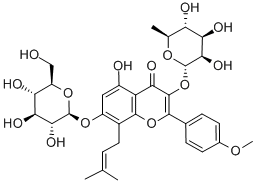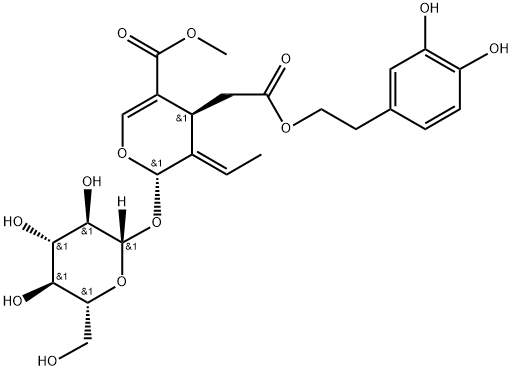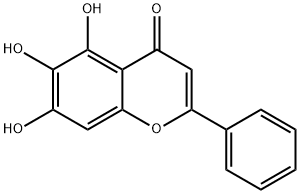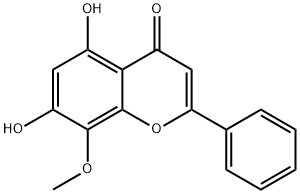Baicalin
Synonym(s):5,6-Dihydroxy-4-oxo-2-phenyl-4H-1-benzopyran-7-yl-β-D-glucopyranosiduronic acid;Baicalein 7-β-D -glucopyranosiduronate;Baicalein 7-O-β-D -glucuronide
- CAS NO.:21967-41-9
- Empirical Formula: C21H18O11
- Molecular Weight: 446.36
- MDL number: MFCD00149302
- EINECS: 606-866-1
- SAFETY DATA SHEET (SDS)
- Update Date: 2025-12-26 16:58:18

What is Baicalin?
Description
Baicalin is one of the main active ingredients obtained from the roots of huang qin (Scutellaria baicalensis Georgi). The Pharmacopoeia of the People’s Republic of China (2015) stipulates that the content of baicalin in radix scutellariae with dry goods shall not be less than 9.0%. The medicinal radix scutellariae distribution in China are now Yunnan radix scutellariae (S. amoena C.?H. Wright), sticky hairs radix scutellariae (S. viscidula Bunge), Gansu radix scutellariae (S. rehderiana Diels), Lijiang radix scutellariae (S. likiangensis Diels), Sichuan radix scutellariae (S. hypericifolia Lev l.), radix scutellariae (S. tenax W.?W. Smith var. patentipilosa G.? Y. Wu), etc., which contain a certain amount of baicalin. Radix scutellariae medicinal has a long history in China. Listed as goods in Shen Nong’s Classic of Materia Medica, it has been used clinically to treat diseases with symptoms such as “heat jaundice, intestinal dysentery, edema, amenorrhea, malignant sore, and scleritis” for about 2000? years. Scutellaria is recorded in the Pharmacopoeia of the People’s Republic of China to have the effects of “clear heat and wet, purging fire to detoxify, stop bleeding and tocolysis.” It is one of the commonly used traditional Chinese herbs, which is clinically used alone or with other Chinese medicine compatibility for the treatment of respiratory infections, acute dysentery, viral hepatitis, allergic disease and gynecological disease, and so on.
Description
Baicalin is a flavonoid that has been found in S. baicalensis and has diverse biological activities. It reduces myocardial apoptosis and increases cardiac microvessel levels of endothelial nitric oxide synthase (eNOS) in a rat model of ischemia-reperfusion injury when administered at doses of 30 and 100 mg/kg. Baicalin (50 and 80 mg/kg) increases the number of intratumor CD8+ T cells and reduces tumor volume in an H22 murine hepatocellular carcinoma model. It reduces LPS-induced cortical production of reactive oxygen species (ROS) and levels of IL-1β and TNF-α in a mouse model of neuroinflammation. Baicalin decreases body weight, increases the number of rats with regular estrous cycles, and ameliorates follicular development in a mouse model of dehydroepiandrosterone-induced polycystic ovary syndrome (PCOS). It also decreases immobility time in the forced swim test in a mouse model of depression induced by chronic mild stress.
Chemical properties
Light yellow powder
Physical properties
Appearance: light yellow crystalline powder at room temperature. Solubility: insoluble in methanol, ethanol, and acetone; slightly soluble in chloroform and nitrobenzene; almost insoluble in water; soluble in hot acetic acid. Melting point: 202–205?°C.
History
The chemical research of the genus Scutellaria began in 1889. Baicalein (scutellarein) is the first flavonoid isolated from Vietnam radix scutellariae (S. altissima) in
1910. In 1922, Shibata Gui Tai and his collaborators isolated and obtained baicalin,
baicalein, wogonin, and benzoic acid from Scutellaria baicalensis.
Among the flavonoids in Scutellaria baicalensis, the content of baicalein is the
highest. Its official name is baikeli. Baicalin is formed by the combination of baicalein and one molecule of glucuronic acid. Both baicalein and baicalin exist in
Scutellaria baicalensis. Studies showed that baicalein could be transferred into
baicalin and other metabolites in the blood. However, baicalin by oral is hardly
absorbed. Baicalein can be absorbed and also rapidly converted into baicalin.
At present, there are a variety of mature extraction methods for obtaining baicalin
and baicalein from Scutellaria baicalensis. Due to the poor water solubility, oral
preparation of baicalin is mostly used in clinical practice. Research showed that
baicalin had a significant first pass effect, which led to its low bioavailability.
Baicalin-metal complexes formed by the combination of baicalin and metal ions
were found to enhance bioavailability and increase pharmacological activities.
In addition, the preparation of ester-type prednisone was easily hydrolyzed by esterase and could improve the lipid solubility of baicalin.
The Uses of Baicalin
Baicalin has been used in a study to examine its neuroprotective effect in chronically stressed rats.2
The Uses of Baicalin
diuretic, prolyl endopeptidase inhibitor, antineoplastic
What are the applications of Application
Baicalin is a flavonoid compound with antioxidant effects
Definition
ChEBI: The glycosyloxyflavone which is the 7-O-glucuronide of baicalein.
Indications
Baicalin is mainly used for the adjuvant therapy of acute and chronic hepatitis and persistent hepatitis.
General Description
Baicalin is a key flavonoid found in the roots of Scutellaria baicalensis. It is known to have different biological activities, such as anti-oxidative, anti-inflammatory, antitumor and anti-apoptotic activities.
Pharmacology
Pharmacological studies showed that both baicalein and baicalin had a variety of
pharmacological effects such as antibacterial, antiviral, removal of oxygen free
radicals, antioxidant, antipyretic, analgesic, anti-inflammatory, antitumor, cardiovascular protecting, cerebrovascular and neuron protecting, liver protecting, and
prevention or treatment of diabetes and its complications
1. Antibacterial and antiviral effects: Scutellaria baicalensis was reported to have
growth inhibitory effect on a variety of Gram-negative bacteria, Gram-positive
bacteria, and spirochetes, showing a broad antibacterial spectrum. Baicalein was
regarded as the main ingredient in Scutellaria baicalensis to play the antibacterial effect. The IC50 of baicalein on Escherichia coli was about 0.29?mmol·L?1
,
and the minimum inhibitory concentration (MICs) of Candida albicans was
264?μg·mL?1
. The survival time of mice infected with influenza virus was significantly extended by the gastric irrigation of baicalin at a dose of
0.96–1.5?g·kg?1.
2. Antitumor effect: In vitro and in vivo experimental results showed that both
baicalein and baicalin had obvious antitumor activity, and the mechanism
involved the inhibition of tumor cell proliferation, invasion and metastasis,
induction of tumor cell apoptosis, suppression of neovascularization, and
enhanced tumor cell chemotherapy sensitivity. Baicalein was found to inhibit theproliferation of rat bladder cancer MBT-2 cells and induce apoptosis, and its IC50
was 0.43?μmol·L?1
. In bladder cancer model formed by injection of MBT-2 cells
into C3H/HeN nude mice, the formed tumor in mouse given baicalein 0.05–
0.1?mg·day?1
for ten consecutive days was significantly smaller than that of the
control group. A 50–200?μmol·L?1
baicalein could inhibit the proliferation of
human prostate cancer DU2145 and PC3 cells, human umbilical vein endothelial
cell proliferation, and the formation of buds and vascular structure in a dosedependent manner. Baicalein could also inhibit human breast cancer cell MDAMB-231 adhesion, metastasis, and invasion, in a dose-dependent manner in the
range of 2–50?μmol·L?1
. Moreover, a dose of 100?μg·mL?1
could also reverse the
resistance of ovarian cancer cell line A2780/ADM.?This reversal may be associated with a decrease in P-gp drug efflux and increased intracellular drug
concentration
3. Antipyretic, analgesic, and anti-inflammatory effects: Both baicalein and baicalin
can play antipyretic, analgesic, and anti-inflammatory effects by interfering with
the arachidonic acid metabolism pathway, inhibiting the activity of nuclear factor, and suppressing the secretion and release. In rats, intraperitoneal injection of
baicalin at a dose of 4.5?mg·kg?1
could exert antipyretic effect; the body temperature of the endotoxin-induced fever rabbits was heavily reduced after intravenous administration of baicalin at a dose of 20?mg·kg?1
; baicalein at a dose of
20?mg·kg?1
(iv) could improve the hemodynamics and heart rate and reduce the
mortality and the leukocyte infiltration into the liver and lung tissues in endotoxic shock rats (LPS 10?mg·kg?1
, iv).
4. Scavenging oxygen free radicals and antioxidant effects: Both baicalein and
baicalin were found to have strong scavenging effects on hydroxyl radicals,
superoxide anion (O2?), alkane peroxy radicals, and DPPH free radicals. A
25–100?μmol·L?1
baicalein can inhibit H2O2-induced RAW264.7 cell apoptosis
and diploid formation.
5. Liver protection: Both baicalein and baicalin were found to have protective effect
on the liver injured by a variety of causes, and the mechanism was related to their
function of antioxidant and inhibition of the secretion of inflammatory mediators. It was found that intraperitoneal injection of baicalin at a dose of
50–200?mg·kg?1
had protective effect on CCl4-induced acute liver injury mice.
Intraperitoneal injection of baicalin at a dose of 70?mg·kg?1
could improve CCl4-
induced chronic liver fibrosis in mice. In addition, gavage of baicalin to mice at
a dose of 50–150?mg·kg?1
significantly reduced the immune liver injury caused
by D-GalN and LPS.
6. Treatment or prevention of diabetes and its complications: Baicalein was found
to have effects of protecting the islet tissue and improving kidney function and
retinopathy in diabetic rats, and the mechanism might ascribe to its function on
reducing the inflammatory response and inhibition of oxidative stress injury.
Streptozotocin-induced diabetic rats were found to have decreased blood glucose concentration and the improvement of islet tissue damage after gavage of
baicalin at a dose of 25–100? mg·kg?1
. After gavage of baicalin at a dose of
80–120?mg·kg?1
for 12?weeks, an obvious protective effect on the kidney tissueof diabetic rats was observed. In addition, the administration of baicalein at a
dose of 150?mg·kg?1
day?1
was found to ameliorate diabetic retinopathy.
7. Cardiovascular and cerebrovascular protective effects: In vitro experiment results
showed that Scutellaria baicalensis had cardiovascular protective effects such as
dilating blood vessels, counteracting high blood pressure, protecting heart and
endothelial cells, and anti-atherosclerosis. Baicalein did not affect normal blood
pressure in rats but could reduce blood pressure in hypertensive rats. Baicalin at
concentration of 0.5 and 2?μmol·L?1
was found to decrease the contractile tension of isolated rat aorta induced by norepinephrine, KCl, and CaCl2, shifting the
reaction curve from the left to the right side and reducing the maximal effect. It
could also significantly inhibit the norepinephrine-dependent contraction
induced by intracellular and outside Ca2+. Baicalein had protective effect on
myocardial ischemia and reperfusion injury, and this effect was stronger than
baicalin. Intravenous injection of baicalein at a dose of 10?mg·kg?1
could improve
the contraction of myocardium in endotoxic shock rats.
8. Neuroprotective effect: Baicalein had a good neuroprotective effect. It could
suppress nerve injury and apoptosis by inhibiting the inflammatory response
induced by glial cell, anti-free radicals, and protection of mitochondria.
Administration of baicalein at a dose of 200?mg·kg?1
could relieve 6-OHDAinduced muscle tremor injury in rats. Gavage of baicalein at a dose of 200?mg·kg?1
could improve the recovery of motor function in Parkinson model mice induced
by 1-methyl-4-phenyl-1,2,3,6-tetrahydropyridine (MPTP). Intraperitoneal injection of baicalein at a dose of 30?mg·kg?1
reduced the neurological deficit score of
MCAO model rats, decreasing brain water content and cerebral infarction volume, which indicated that baicalein had a protective effect on the neurological
function of rats with focal cerebral ischemia.
9. Other effects: Baicalein and baicalin were also reported to have other pharmacological effects such as enhancing immune function.
Clinical Use
In clinical, baicalin is mainly used as the adjuvant therapy for acute and chronic
hepatitis and persistent hepatitis. Baicalin was shown to reduce the expression of
hepatitis B surface antigen, e antigen and the core antigen, and inhibited hepatitis B
virus DNA replication. Reduced serum alanine aminotransferase level was observed
in hepatitis patient treated with baicalin, and other liver function indexes were also
found to be improved. No adverse reactions about baicalin have been reported. In
addition, baicalin was reported to treat early diabetic nephropathy and alleviate the
symptoms of diabetic neuropathy
As one of the antimicrobial components of Scutellaria baicalensis, eye drops
containing 3% baicalin are used clinically in the treatment of trachoma, with the
similar curative effect as rifampicin.
Moreover, baicalein is used clinically for the treatment of enteritis and
dysentery.
Enzyme inhibitor
This baicalein glucuronide (FW = 446.36 g/mol; CAS 21967-41-9), also known as 5,6-dihydroxy-4-oxygen-2-phenyl-4H-1-benzopyran-7-b-D glucopyranose acid, is a flavone prodrug found in the Chinese medicinal herb Huang-chin (Scutellaria baicalensis) that is hydrolyzed to baicalein (See Baicalein). Baicalin is a slow, tight-binding inhibitor of Jack Bean urease, rapidly forming initial BA-urease complex (Ki = 3.9 × 10–3 M) that slowly isomerizes to the final complex (overall inhibition constant of Ki* = 0.15 × 10 μM. Inhibition can be reversed by dithiothreitol but not dilution of substrate. Baicalin also inhibits prolyl oligopeptidase, a cytosolic serine peptidase that hydrolyzes proline-containing peptides at the carboxy terminus of proline residues and is associated with schizophrenia, bipolar affective disorder, and related neuropsychiatric disorders. (See Pramiracetam)
Properties of Baicalin
| Melting point: | 202-205 °C (dec.) (lit.) |
| alpha | -85 º (c=1, DMSO) |
| Boiling point: | 836.6±65.0 °C(Predicted) |
| Density | 1.737±0.06 g/cm3(Predicted) |
| storage temp. | 2-8°C |
| solubility | DMSO (Slightly), Methanol (Slightly) |
| form | solid |
| pka | 2.72±0.70(Predicted) |
| color | Pale Yellow to Yellow |
| optical activity | [α]20/D 85°, c = 1 in DMSO |
| Stability: | Hygroscopic |
| CAS DataBase Reference | 21967-41-9(CAS DataBase Reference) |
Safety information for Baicalin
| Signal word | Warning |
| Pictogram(s) |
 Exclamation Mark Irritant GHS07 |
| GHS Hazard Statements |
H302:Acute toxicity,oral |
| Precautionary Statement Codes |
P264:Wash hands thoroughly after handling. P264:Wash skin thouroughly after handling. P270:Do not eat, drink or smoke when using this product. P301+P312:IF SWALLOWED: call a POISON CENTER or doctor/physician IF you feel unwell. P501:Dispose of contents/container to..… |
Computed Descriptors for Baicalin
| InChIKey | IKIIZLYTISPENI-ZFORQUDYSA-N |
| SMILES | OC1C(=C(O[C@H]2[C@@H]([C@@H](O)[C@H](O)[C@@H](C(=O)O)O2)O)C=C2OC(C3C=CC=CC=3)=CC(=O)C=12)O |&1:5,6,7,9,11,r| |
Baicalin manufacturer
New Products
4,4-Difluoropiperidine hydrochloride tert-butyl 9-methoxy-3-azaspiro[5.5]undecane-3-carboxylate Indole Methyl Resin N-Isopropylurea N,N-Dicyclohexylcarbodiimide(DCC) MELDRUMS ACID 5-METHYLISOXAZOLE-4-CARBOXYLIC ACID Magnessium Bis glycinate Zinc ascorbate 1-bromo-2-butyne 2-acetamidophenol 9(10H)-anthracenone Erythrosin B, 4-Piperidinopiperidine 2-((4-morpholinophenylamino) (methylthio) methylene) malononitrile 2,4-dihydroxybenzaldehyde 3-(4-morpholinophenylamino)-5-amino-1H-pyrazole-4-carbonitrile Methyl 2-methylquinoline-6-carboxylate 2,6-dichloro-4-nitropyridine 4-Bromo-2-chlorobenzonitrile 2-(benzylamino)acetic acid hydrochloride 4-(tert-Butoxycarbonylamino)but- 2-ynoic acid 3,4-dihydro-2H-benzo[b][1,4]dioxepine 1-Phenyl-1-cycloprppanecarboxylicacidRelated products of tetrahydrofuran
You may like
-
 Baicalin, 95%+ CAS 21967-41-9View Details
Baicalin, 95%+ CAS 21967-41-9View Details
21967-41-9 -
 Baicalin CAS 21967-41-9View Details
Baicalin CAS 21967-41-9View Details
21967-41-9 -
 Baicalin 98% CAS 21967-41-9View Details
Baicalin 98% CAS 21967-41-9View Details
21967-41-9 -
 Baicalin CAS 21967-41-9View Details
Baicalin CAS 21967-41-9View Details
21967-41-9 -
 Baicalin CAS 21967-41-9View Details
Baicalin CAS 21967-41-9View Details
21967-41-9 -
 Baicalin, 95%+View Details
Baicalin, 95%+View Details
21967-41-9 -
 20677-73-0 (2,2-diethoxyethyl)methylamine 98%View Details
20677-73-0 (2,2-diethoxyethyl)methylamine 98%View Details
20677-73-0 -
 3-(4-(hydroxyamino)-1-oxoisoindolin-2-yl)piperidine-2,6-dione 98%View Details
3-(4-(hydroxyamino)-1-oxoisoindolin-2-yl)piperidine-2,6-dione 98%View Details







